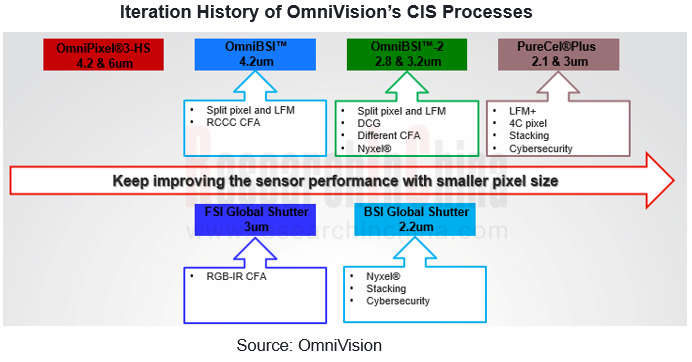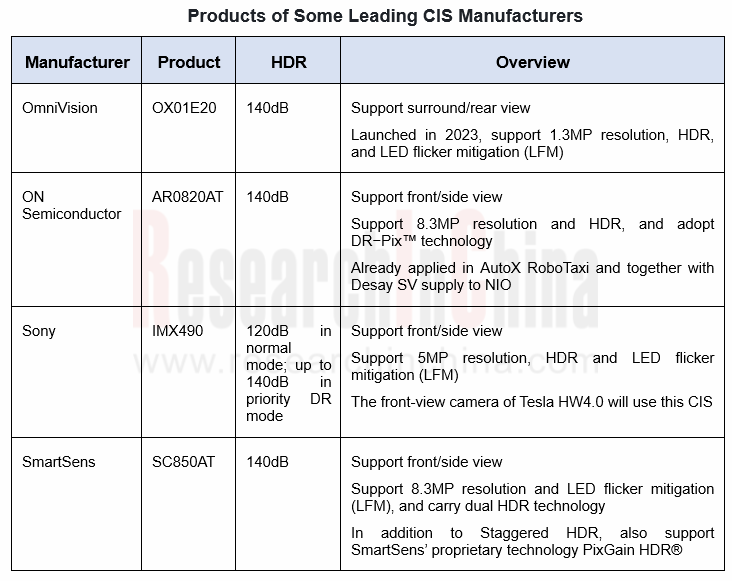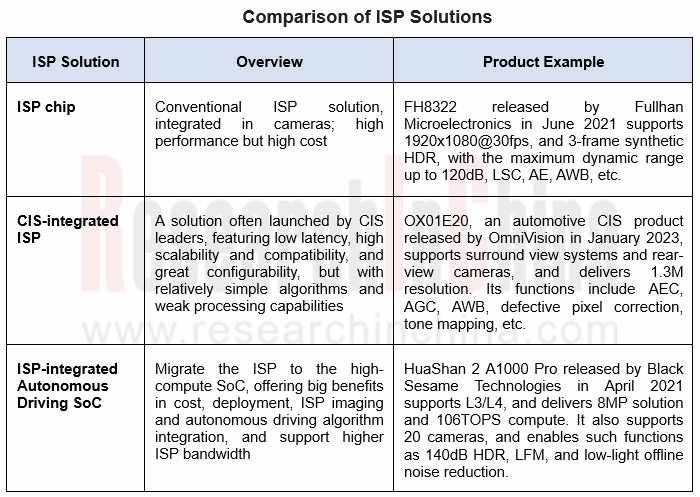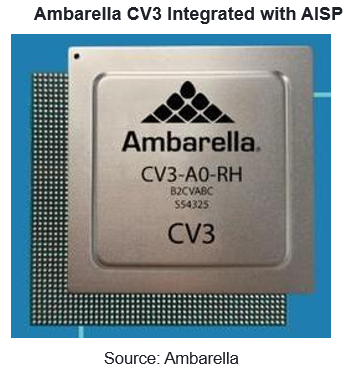1. The automotive camera market maintains a pattern of "one superpower and several great powers".
Automotive cameras are used to focus the light reflected from the target onto the CIS after refraction. From the automotive camera industry chain, it can be seen that main upstream companies are: lens, optical filter, and protective film companies which are committed to processing raw materials and making them into basic hardware such as lenses, optical filters and protective films; main downstream players are: Tier1 suppliers and camera module packaging companies.
At present, the automotive camera module market features a pattern of "one superpower and several great powers", that is, Chinese manufacturer Sunny Optical Technology rules the roost, and Japanese, Korean and other Chinese manufacturers compete in the second echelon.
"One superpower" is Sunny Optical Technology, the automotive camera industry bellwether that has grabbed the biggest share of the global market for many years in a row. The company shipped 67.98 million automotive cameras in 2021, and 78.91 million units in 2022, with a stable market share higher than 30%.
"Several great powers" refer to the several leaders in the second echelon, mainly Japanese, Korean and other Chinese manufacturers, commanding 2% to 10% of the market. The traditional "great powers" are led by Japanese, Korean and Taiwanese optics companies, including Maxell (Japan), Nidec Sankyo (Japan), Sekonix (South Korea) and Largan Precision (China Taiwan). Among them, Maxell took an 8% share in the global automotive camera market in 2021.
Meanwhile Chinese companies such as Lianchuang Electronic Technology and OFILM begin to edge into the "great powers" club.
Lianchuang Electronic Technology shipped about 8 to 9 million automotive cameras in 2022, and its major customers were Tier1 suppliers such as Valeo, Continental, Aptiv, ZF and Magna. OFILM set foot in automotive cameras by acquiring Fujifilm in 2018. Up to now, OFILM has mass-produced 5M front view cameras, 3M/8M side view cameras, 1M/2.5M surround view cameras, 2M electronic exterior mirror cameras, and 1M/2M in-cabin DMS/OMS cameras. In 2022, OFILM shipped about 4 million automotive cameras.
In addition, the established optics companies like Phenix Optics and Dongguan Yutong Optical Technology (YTOT) have also made deployments in the automotive market. Among them, Phoenix Optics has launched more than ten types of automotive cameras; YTOT, a leader in the field of security cameras, bought a 20% stake in Jiuzhou Optical in 2022, one of its attempts to step into the automotive camera market. In the future, these old optics companies will take further efforts to seize a share of the automotive camera market.
2. Automotive CIS offers increasing performance, up to 8M resolution and 140dB HDR.
The working process of CIS (CMOS image sensor) generally covers several links: reset, photoelectric conversion, integration, and readout.
In terms of the camera industry chain, the upstream CIS manufacturers include: CIS intellectual property (IP) companies specializing in CIS design and selling IPs to CIS companies; wafer companies providing silicon chips; OSAT companies engaged in cutting and packaging processed wafers. As with the automotive camera industry, downstream manufacturers are Tier 1 suppliers and camera module packaging companies.
In the trend for vehicle intelligence, the increasing camera pixels also pose higher technical requirements for CIS. As automotive cameras tend to be miniaturized and lightweight, pixel size cut and architecture upgrade have become most commonplace.
Take OmniVision's CIS process iteration as an example: in the iteration of processes like OmniPixel?3-HS, OmniBSI? and PureCel?Plus, the pixel size has been reduced from 4.2um to 2.1um. By specific products, OX08B40 unveiled by OmniVision in 2021 delivers 8MP resolution and adopts the PureCel? Plus-S pixel architecture, a technology that uses a stacked architecture for high resolution with a smaller chip size.

In addition to resolution, HDR is also one of the key technical parameters of CIS. In type’s term, front/side view cameras have begun to pack 140dB HDR CIS, while rear/surround view cameras are still at the 120dB stage.
As core sensors for advanced AD, front/side view cameras need to quickly recognize details in brightness and darkness in different lighting conditions and accurately capture images when driving at high speeds. 120dB HDR therefore is the basic requirement, and 140dB HDR is the current trend. Some manufacturers have also laid out 140+dB HDR. One example is ONSemiconductor which announced the launch of a 150dB HDR vehicle CIS in October 2022 and planned to start producing it in 2024. In the future, CIS for ADAS may reach 150+dB HDR.
Rear/surround view cameras generally still offer 120dB, and will evolve to 140dB in the future. For example, CIS OX01E20 for surround/rear view, announced by OmniVision in 2023, supports 140dB HDR, 1.3MP resolution, and LED flicker mitigation (LFM).

3. Automotive ISP solutions tend to be diversified, and AI ISP will become a development trend.
Among automotive camera component modules, ISP (image signal processor) is a core component for adjusting images. To achieve ideal imaging effects, ISP Tuning is an essential step.
In addition to conventional ISPs, there are also another two types of mainstream ISP solutions: CIS integrated ISP, and ISP integrated autonomous driving SoC. The solutions become diversified.
The diversity of ISP solutions and the necessity of ISP Tuning make ISP seen in multiple links of the camera industry chain.

The importance of ISP and its low requirement for fixed hardware architecture make itself a high ground leading manufacturers from various fields contend to gain. Players often deploy 1 or 2 solutions.
For example, Fullhan Microelectronics specializes in ISP products; SmartSens has launched several ISP-integrated CIS products; OmniVision makes layout of "ISP + ISP-integrated CIS"; NXP and Nextchip deploy "ISP + ISP-integrated autonomous driving SoC”. Moreover, autonomous driving SoC companies like Mobileye, Nvidia and Black Sesame Technologies have also rolled out ISP-integrated autonomous driving chips.
Besides diversity of solutions, AI ISP is also an important development direction of ISP.
ISP covers dozens of image signal processing algorithms, but the coordination of so many algorithms requires a lot of debugging efforts. At present, the development of visual ADAS systems still relies on manual ISP Tuning. OEMs like Tesla and NIO are still recruiting a large number of image quality tuning engineers. Yet manual tuning takes a long time and requires very specialist ISP Tuning engineers.
In recent years, using AI for image enhancement has gradually become a new research hotspot in the industry, having made remarkable progress. Applying AI for real-time tuning, especially the efficient implementation of AI ISP functions in the computing environment on the terminal side, can achieve better results than conventional ISP Tuning.
For example, Ambarella announced an artificial intelligence image signal processor (AISP). Ambarella’s new AI based ISP architecture uses neural networks to augment the image processing done by the hardware ISP integrated into its SoCs. This approach enables color imaging with low light at very low lux levels and minimal noise, a 10 to 100X improvement over state-of-the-art traditional ISPs, and new levels of high dynamic range (HDR) processing with more natural color reproduction and higher dynamic range.
Ambarella's CV3 AI domain controller family already packs AISP, with up to 500 eTOPS of AI compute. The ISP can simultaneously support more than 20 cameras connected through MIPI VC, and can meet the requirements for high-performance stereo and dense optical-flow engines.

Analysis on Geely's Layout in Electrification, Connectivity, Intelligence and Sharing
Geely, one of the leading automotive groups in China, makes comprehensive layout in electrification, connectivity, intelligence and sharing.
Geely boasts more than ten brands. In 2023, it sold a tota...
48V Low-voltage Power Distribution Network (PDN) Architecture Industry Report, 2024
Automotive low-voltage PDN architecture evolves from 12V to 48V system.
Since 1950, the automotive industry has introduced the 12V system to power lighting, entertainment, electronic control units an...
Automotive Ultrasonic Radar and OEMs’ Parking Route Research Report, 2024
1. Over 220 million ultrasonic radars will be installed in 2028.
In recent years, the installations of ultrasonic radars in passenger cars in China surged, up to 121.955 million units in 2023, jumpin...
Automotive AI Foundation Model Technology and Application Trends Report, 2023-2024
Since 2023 ever more vehicle models have begun to be connected with foundation models, and an increasing number of Tier1s have launched automotive foundation model solutions. Especially Tesla’s big pr...
Qualcomm 8295 Based Cockpit Domain Controller Dismantling Analysis Report
ResearchInChina dismantled 8295-based cockpit domain controller of an electric sedan launched in December 2023, and produced the report SA8295P Series Based Cockpit Domain Controller Analysis and Dism...
Global and China Automotive Comfort System (Seating system, Air Conditioning System) Research Report, 2024
Automotive comfort systems include seating system, air conditioning system, soundproof system and chassis suspension to improve comfort of drivers and passengers. This report highlights seating system...
Automotive Memory Chip and Storage Industry Report, 2024
The global automotive memory chip market was worth USD4.76 billion in 2023, and it is expected to reach USD10.25 billion in 2028 boosted by high-level autonomous driving. The automotive storage market...
Automotive AUTOSAR Platform Research Report, 2024
AUTOSAR Platform research: the pace of spawning the domestic basic software + full-stack chip solutions quickens.
In the trend towards software-defined vehicles, AUTOSAR is evolving towards a more o...
China Passenger Car Electronic Control Suspension Industry Research Report, 2024
Research on Electronic Control Suspension: The assembly volume of Air Suspension increased by 113% year-on-year in 2023, and the magic carpet suspension of independent brands achieved a breakthrough
...
Global and China Hybrid Electric Vehicle (HEV) Research Report, 2023-2024
1. In 2025, the share of plug-in/extended-range hybrid electric passenger cars by sales in China is expected to rise to 40%.
In 2023, China sold 2.754 million plug-in/extended-range hybrid electric p...
L3/L4 Autonomous Driving and Startups Research Report, 2024
The favorable policies for the autonomous driving industry will speed up the commercialization of L3/L4.
In the second half of 2023, China introduced a range of policies concerning autonomous drivin...
Intelligent Vehicle Cockpit-driving Integration (Cockpit-driving-parking) Industry Report, 2024
At present, EEA is developing from the distributed type to domain centralization and cross-domain fusion. The trend for internal and external integration of domain controllers, especially the integrat...
Global and China Automotive Operating System (OS) Industry Report, 2023-2024
Chinese operating systems start to work hard In 2023, Chinese providers such as Huawei, Banma Zhixing, Xiaomi, and NIO made efforts in operating system market, launched different versions with competi...
Automotive RISC-V Chip Industry Research Report, 2024
Automotive RISC-V Research: Customized chips may become the future trend, and RISC-V will challenge ARM
What is RISC-V?Reduced Instruction Set Computing - Five (RISC-V) is an open standard instructio...
Passenger Car CTP (Cell to Pack), CTC (Cell To Chassis) and CTB (Cell to Body) Integrated Battery Industry Report, 2024
Passenger Car CTP, CTC and CTB Integrated Battery Industry Report, 2024 released by ResearchInChina summarizes and studies the status quo of CTP (Cell to Pack), CTC (Cell To Chassis) and CTB (Cell to ...
Software-defined Vehicle Research Report, 2023-2024 - Industry Panorama and Strategy
1. How to build intelligent driving software-defined vehicle (SDV) architecture?
The autonomous driving intelligent platform can be roughly divided into four parts from the bottom up: hardware platf...
Automotive DMS/OMS (Driver/Occupant Monitoring System) Research Report, 2023-2024
In-cabin Monitoring study: installation rate increases by 81.3% in first ten months of 2023, what are the driving factors?
ResearchInChina released "Automotive DMS/OMS (Driver/Occupant Monitoring Sys...
Automotive Functional Safety and Safety Of The Intended Functionality (SOTIF) Research Report, 2024
As intelligent connected vehicles boom, the change in automotive EEA has been accelerated, and the risks caused by electronic and electrical failures have become ever higher. As a result, functional s...